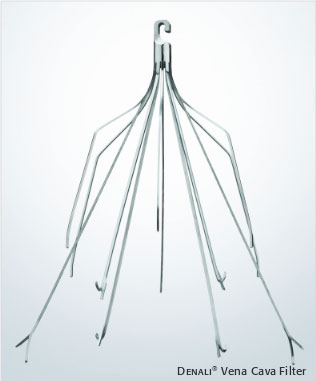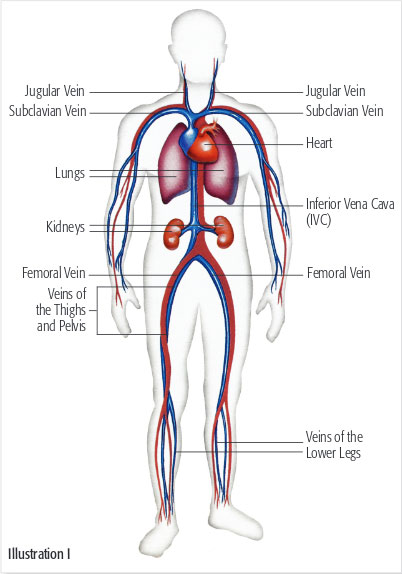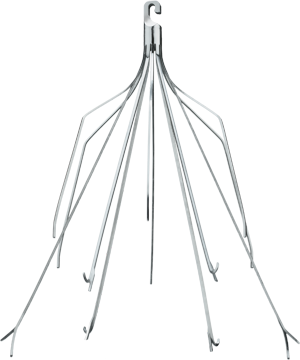 |
|
|
 |
 |
Patient Information
Download Full Patient Guide (Spanish Version)
Pulmonary Embolism

This website is intended to help you learn more about pulmonary embolism - what causes it, how it can affect your body, and most importantly, how it can be treated. After reviewing this website, talk to your doctor about any questions you have. It's important to remember that each patient is different and that only your doctor can give you information about the details of your specific treatment.
What is Pulmonary Embolism and What are the Causes of it?
Pulmonary embolism is the condition that results when a blood clot forms, usually in the deep veins of the thighs, pelvis or lower leg, and becomes loosened, traveling upward in the bloodstream to lodge in the arteries that carry blood to the lungs. This can lead to decreased blood flow to the lungs and may cause lung damage or death.
What Types of Treatment are used for Pulmonary Embolism?
The most common treatment is a group of medications called anticoagulants or "blood thinners". However, there are some patients who, for a variety of medical reasons, cannot take anticoagulants. For these individuals, a vena cava filter may offer an effective preventative option to prevent clot movement to the lungs.
Download Full Patient Guide (Spanish Version)
Vena Cava Filters

What is a Vena Cava Filter?
A vena cava filter is an expandable metal device specially designed to trap blood clots before they reach the lungs. The filter is placed in the inferior vena cava (IVC) - the large vein that carries blood from the lower extremities back to the heart and lungs - and remains in place to trap clots before they move further up towards the lungs.
Download Full Patient Guide (Spanish Version)
The Implant Procedure
 How Will the Filter be Inserted?
Your physician will insert the filter through the femoral, jugular or subclavian vein. To make the procedure as easy as possible, the filter is delivered through a small plastic tube called a catheter. Once implanted, the filter expands to its predetermined shape and is held in place against the vena cava walls.
How Long Does the Procedure Usually Take?
Although it varies depending upon the individual patient and the specific circumstances, the implantation of the filter generally takes less than an hour.
Will I Experience Discomfort During and After the Procedure?
Local anethesia, plus a mild sedative that might be taken before the procedure, will normally result in little to no discomfort while the filter is being implanted.
Afterwards, you may experience mild soreness at the insertion site. This is normal and should disappear. You will be left with a small scar at the puncture site.
How Long Will it Take to Fully Recover?
Recovery from the procedure should be rapid, although the specific length of time will vary from patient to patient, depending upon the factors such as age, general state of health, etc.
After the Procedure
How Long Will the Filter Last and Can the Filter be Removed?
A Bard® Optional Vena Cava Filter is designed to be a permanent implant. However, the filter can be removed when your physician determines that you no longer need it.
Can the Filter Become Clogged?
In the great majority of cases, the answer is "no." Once a clot becomes entrapped in the filter, the normal flow of your blood through the vena cava and the filter will usually dissolve a trapped clot as the blood flows over it.
If I Should Need an MRI Exam, Will the Metal Interfere with the Test?
Bard® Optional Vena Cava Filters are made from an alloy of nickel and titanium, which under certain circumstances has been considered safe. It is recommended if you have a vena cava filter to register the MR conditions with the MedicAlert Foundation (www.medicalert.org) and let your doctor or nurse know that you have a vena cava filter before an MRI exam. The Bard® Optional Vena Cava Filter can be safely scanned at 3-Tesla or 1.5-Tesla.
Under What Circumstances Should I Contact the Doctor Right Away?
You should contact your physician right away if you experience any of the following:
- Sudden onset of chest pain accompanied by shortness of breath
- Swelling in the legs
- Unexplained pain in the abdomen or back
- Sudden numbness or weakness of the face, arm, or leg (especially on one side of the body)
- Sudden confusion, trouble speaking or understanding
- Sudden trouble seeing in one or both eyes
- Sudden severe headache with no known cause
- Sudden trouble walking or dizziness
- Unexplained fever
What are the Risks Associated with Implantable Filters?
As with all implantable devices, there are some risks associated with vena cava filters. You should discuss the possible adverse effects of this procedure and the filter with your physician. Potential risks include the following:
- Any procedure where the skin is penetrated carries a risk of infection.
- The filter could accidently be implanted in the wrong place, move from its initial implantation site, or poke or tear through the vessel wall.
- The events above may lead to pain, bleeding, injury to a nearby organ, or make it difficult or impossible to remove the filter (should your doctor wish to remove it).
- Blood clots could continue to reoccur and possibly obstruct the filter and vena cava, causing swelling in the legs.
- The entire filter or pieces of the filter may break loose and travel to the heart or lungs, causing injury or death. You may need to have additional surgery to retrieve the filter or pieces if they break loose.
- Even with a filter it is possible to experience a recurrent pulmonary embolism due to clot material passing through the small openings in the filter.
Can the Filter be Removed?
Yes. The filter can be removed when your physician determines that you no longer need it.
Should the Filter be Removed?
FDA recommends that implanting physicians and doctors responsible for ongoing care, consider removing the filter as soon as protection from pulmonary embolism is no longer needed. Discuss your follow-up schedule with your physician.
Resuming Your Normal Lifestyle
Should I Restrict My Activities After the Filter Implantation Procedure?
The implantation or removal of a vena cava filter is not necessarily a reason to restrict your normal activity level; however, each patient is unique and there may be other medical reasons for doing so. Be sure to discuss with your doctor what level of activity is most appropriate for you following the procedure.
Download Full Patient Guide (Spanish Version)
Removal Procedure

How Will the Filter be Removed?
Your physician will remove the filter through either the right or left internal jugular vein (see Illustration I). He/she will insert a small tube called a catheter. Through the catheter, a grasping device will be advanced to the filter. The filter will be grasped, and then pulled into the catheter. Your physician will then remove the entire system. However, some filters may not be able to be removed. In this case, your physician may choose to leave the filter in place as a permanent device. Should this occur, follow-up may be necessary to monitor the device.
Will I Experience Discomfort During and After the Procedure?
As with the implant procedure, local anesthesia, helped by a mild sedative given before the procedure, will normally result in little to no discomfort while the filter is being removed. Afterwards, you may experience mild soreness in your neck for a few days. This is normal and will disappear. You will be left with a small scar on your neck at the puncture site.
How Long Will it Take to Fully Recover from the Removal Procedure?
Recovery from the removal procedure should be rapid, although the specific length of time will vary from patient to patient, depending upon factors such as age, general state of health, etc. Typically, you will be discharged several (2-3) hours after the procedure.
Does the Filter Have to be Removed?
No. Bard® Optional Vena Cava Filters are designed to be permanently implanted and do not have to be removed, repositioned or replaced. However, in the cases where the risk for pulmonary embolism is temporary, your physician may choose to remove the filter. You should discuss filter removal with your physician.
Resuming Your Normal Lifestyle
Should I Restrict My Activities After the Removal Procedure?
The implantation or removal of a vena cava filter is not necessarily a reason to restrict your normal activity level; however, each patient is unique and there may be other medical reasons for doing so. Be sure to discuss with your doctor what level of activity is most appropriate for you following the procedure.
|

Bard® Resources
Products
IFU
Patient Q&A Booklet
Brochures
Procedure Animations
Bard no longer manufactures or sells the Meridian®, Eclipse®, G2X®, G2®, and Recovery™ Filters.
Bard no longer distributes the Simon Nitinol® Filter in the United States.
|
Physician Information
Denali Trial (Final Analysis)
Stavropoulos, William et al. "Analysis of the Final DENALI Trial Data: A Prospective, Multicenter Study of the Denali Inferior Vena Cava Filter" Journal of Vascular and Interventional Radiology. 2016; Volume 27, Issue 10:1531-1538.
Purpose: To report the final 2-year data on the efficacy and safety of a nitinol retrievable inferior vena cava (IVC) filter for protection against pulmonary embolism (PE).
- Prospective, multi-center, non-randomized
- 200 Patients
- 200 Day Mean Indwell Time
- 736 Day Max Indwell Time
- 125 Filter Retrieval Attempts
- 97.6% Retrieval Success Rate
Conclusion: The Denali® IVC filter exhibited high success rates for filter placement and retrieval while maintaining a low complication rate in this clinical trial.
Bard Reach®
The Bard Reach® Program is an industry-leading initiative designed to help physicians contact their Bard® Optional Vena Cava Filter patients. The program:
- Supplements physician efforts to bring patients with Bard® Optional Vena Cava Filters back to the practice for follow up
- Provides a tool to track Bard® Optional Vena Cava Filter patients
When a physician registers for the free Bard Reach® Program, he or she receives access to a secure web portal and the services of professional Patient Support Representatives. The representatives contact the patients and encourage them to return for initial follow-up or retrieval.
How does the program work?
- Complete a one-time online registration and agree to the terms that allow McKesson, a third-party patient outreach group, to contact patients on your behalf.
- After implanting a Bard® Optional Vena Cava Filter, enroll the patient using the secure web portal.
- A McKesson Patient Support Representative contacts the patient on your behalf encouraging him or her to schedule and attend a follow-up consult.
PHYSICIANS REGISTER NOW
Guidelines & Resources
For additional vena cava filter clinical information please refer to the following guidelines:
- FDA Communication Regarding IVC Filters, Issued May 6, 2014
- "Quality Improvement Guidelines for the Performance of Inferior Vena Cava Filter Placement for the Prevention of Pulmonary Embolism." [SIR Quality Improvement Guidelines, JVIR 2011, 22:1499-1506]
- "ACR-SIR Practice Parameter for the Performance of Inferior Vena Cava (IVC) Filter Placement for the Prevention of Pulmonary Embolism" [ACR Practice Parameter 2014]
- "Antithrombotic Therapy and Prevention of Thrombosis, 9th Ed: American College of Chest Physicians Evidence-Based Clinical Practice Guidelines" [CHEST 2012; 141(2 suppl)]
- "Practice Management Guidelines for the Prevention of Venous Thromboembolism in Trauma Patients: The EAST Practice Management Guidelines Work Group" [J Trauma 2002; 53:142-614]
Additional Resources
Clinical Studies
Everest Study
Binkert, Christoph et al. "Technical Success and Safety of Retrieval of the G2 Filter in a Prospective, Multicenter Study." Journal of Vascular and Interventional Radiology. 2009; 20:1449-1453
Results of a prospective, multi-center, non-randomized single arm clinical trial
Purpose: To assess the technical success and retrievability of the G2 Vena Cava Filter.
- Prospective, multi-center, single arm, non-randomized clinical trial
- 100 Patients
- 140 Days Mean Indwell Time
- 61 Filter Retrieval Attempts
- 95% Retrieval Success Rate
Conclusion: Retrieval of the G2 Vena Cava Filter was successful in most patients
Charles et al.
Charles, Hearn et al. "G2 Inferior Vena Cava Filter: Retrievability and Safety." Journal of Vascular and Interventional Radiology; 2008; 20(8): 1046-1051
Purpose: To assess the retrievability of the G2 inferior vena cava (IVC) filter and factors influencing the safety and technical success of retrieval.
- Prospective, single-center, non-randomized
- Mean Indwell Time 122 Days (range, 11-260 days)
- 27 Filter Retrieval Attempts
- 100% Technical Success
- Tilting (>15°) occurred in 5 Patients (18.5%)
- No Significant Migration (cephalad or caudal)
- No Angiographic Demonstration of Thrombus
- No Strut Fractures
Conclusion: The G2® IVC filter retrieval has a high technical success rate and a low complication rate. Technical success appears to be unaffected by the dwell time within the reported range.
Oliva, Vincent et al.
Oliva, Vincent et al. “Recovery G2 Inferior Vena Cava Filter: Technical Success and Safety of Retrieval.” Journal of Vascular and Interventional Radiology; 2008;19:884-889
Purpose: To assess the safety and technical success of the retrieval of the Recovery® G2 filter when implanted for temporary protection against pulmonary embolism. Results of a Prospective, single-center, consecutive single arm clinical trial.
- Prospective, single-center, non-randomized
- 120 Patients
- 53.4 Days Mean Indwell Time
- 51 Filter Retrieval Attempts
- 100% Retrieval Success Rate
Conclusion: Retrieval of the Recovery G2® filter is safe and can be performed successfully in patients who no longer need IVC filtration.
|
|
 |
 |
 |
 |
|
 |
 |
 |
|
|
|
